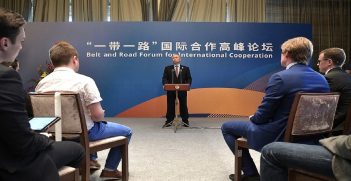Beijing is Adopting a Wedge Strategy in the Pacific

Beijing’s proposed agreement with ten Pacific Island countries faced a setback last week. Now China is looking for a wedge strategy to prevent a hostile alignment from arising, a policy of differentiation that will likely target Fiji and Solomon Islands.
Eight years on from Xi Jinping’s visit to the South Pacific in 2014, Wang Yi’s diplomatic tour of eight Pacific Island countries has gained international attention. The top-level visit demonstrates China’s ambitious long-term strategy and growing focus on this region. Given China’s global interests and the geopolitical importance of the Pacific countries, once Beijing entrenches itself in the region with deep political and economic ties, China is likely to significantly ease the geopolitical dilemma of encirclement of the “Island Chain” – the strategy of containment to limit Beijing’s power projection to the Pacific through the US-backed islands countries surrounding China.
Two days after Wang Yi’s charm offensive, the newly elected Australian Foreign Minister Penny Wong also visited Fiji, signalling that the Albanese government would attempt to be more active and confident in their engagement with Pacific allies.
Morrison’s indifferent attitude toward traditional partners in the South Pacific gave China an opportunity to establish a sphere of influence in the region. Since 2009, the Chinese government has increased its official development assistance to Pacific Island countries from US $63 million in 2009 to a peak of $246 million in 2018, and signed multiple treaties along the way. Today, China is still one of the biggest donors in the region.
However, China’s progress did not go smoothly, as Wang Yi’s regional agreement was shelved. Before Wang’s visit, China reportedly sent the foreign ministers of Pacific Island countries a draft entitled “The China-Pacific Island Countries Common Development,” in which China laid out its position and expectations for more involvement, including not only a deeper economic connection but also political cooperation, such as policing, cybersecurity, and marine mapping.
It is no surprise that the Common Development was not accepted. As China’s diplomacy becomes more confrontational and aggressive, and the conflict between China and Australia continues to intensify, Pacific Island countries must be increasingly careful not to be entrapped into the great power conflict. Additionally, the credibility and transparency of China’s economic commitments, and considerations of sovereignty and independent status remain important considerations to Pacific states and influenced their decision to shelf the Common Vision. For instance, in Micronesian President David Panuelo’s letter to other Pacific Islands leaders, he noted that China’s proposal for free trade area is disingenuous since Beijing has a hidden agenda. He said that Common Development seeks Chinese economic control of Pacific resources through Belt & Road Initiative and the Asian Infrastructure Investment Bank. Similarly, Samoa Prime Minister Fiamē Naomi Mataʻafa complained that this particular proposal seemed a bit abnormal and Pacific states “did not have enough time to look at it.” Considering her previous decision to scrap China-backed Vaiusu Bay port project due to the debt risk, Samoa, just as Micronesia, are sceptical of China’s economic expansion.
Nevertheless, this setback does not mean Wang’s visit gained nothing — a wedge strategy based on differentiation emerged in this visit. Although Australia and some Pacific countries hope to iron out internal differences, China is realising its political goals through a wedge strategy. Such a strategy aims to divide potential opposing alliance, in which the state uses different policies to deal with different targets to prevent a hostile coalition from forming. Therefore, the purpose of this strategy is not to construct a consensus or regional agreement, but to find breakthrough points as a foothold in the region. In this sense, the failure of regional agreement can be hardly seen as a setback for Beijing, as China can get what it wants by other means.
Unlike the family metaphor that Australia prefers, Pacific Island countries are different. Fiji and the Solomon Islands have more room for diplomatic negotiation by virtue of their geostrategic importance and relatively independent political postures. In contrast, two key actors which rejected Wang’s proposal – Micronesia and Samoa – possess cooperation traditions and security agreements with the USA.
Interactions between China-Fiji and China-Solomon Islands illustrate China’s intention to wedge into the “Pacific family.” Fiji became a founding member of the Indo-Pacific Economic Framework – Biden’s effort to counter China’s influence – while sending an olive branch to China at the same time. China has a long-standing trade relationship with Fiji, the first Pacific Island country to establish diplomatic relations with China, and China’s second-largest trading partner in the South Pacific. China is Fiji’s fourth-largest importer. From Xi Jinping’s visit to Fiji in 2014 and his pledge of generous economic assistance, China’s direct investment in Fiji has reached US $183 Million. Also, China has established Confucius Institutes, educational exchange programs, and a well-staffed diplomatic team in Fiji to expand its influence.
Although Fiji has rejected China’s offer of a security agreement, it has signed three economic cooperation agreements with Beijing. More importantly, Fiji clearly demonstrated that its reason for refusal is the “consensus first” approach that requires Pacific countries to prioritise the consensus regarding regional agreements, which leaves room for more bilateral coordination in the future. To express its good intentions, Fiji showed great respect for China’s visit. Referring to the West’s approach to the pandemic and climate change, the Fijian Prime Minister shared his displeasure with Wang Yi. This stance is an extremely important display for China, and it means that Fiji is standing with China against the West on some critical issues.
The Solomon Islands, on the other hand, is an emerging partner for Beijing in the South Pacific. The Solomon Islands broke diplomatic ties with Taiwan in favour of Beijing in April 2019, and since then, Beijing has provided US $500 million in aid. The diplomatic shift was quickly seized upon by Beijing and used as a breakthrough point to expand its political and military presence in the South Pacific. In April this year, China signed a security agreement with the Solomon Islands, which recognises China’s right to send military, police, and law enforcement. While there is no official acknowledgment of any intention to establish a military base, concerns remain that China could use the Solomon Islands as a base in the Pacific.
The Pacific Islands are becoming another arena of great power competition, but these countries are not a monolith. While Australia’s “Pacific family” and the “consensus first” of the Pacific countries continue to call for foreign policy coordination, the different historical experiences, and cultural and political backgrounds give Beijing an opportunity to exploit the wedge strategy to achieve strategic objectives. The failure of Beijing’s regional agreement is not the end of its diplomatic adventure, but a reminder that different and targeted policies will be applied.
Guangyi Pan is a PhD candidate in International Politics at UNSW.
This article is published under a Creative Commons Licence and may be republished with attribution.





